Norbert Wu reviews fins
A Review of Fins for Scuba Diving and Snorkeling
By Norbert Wu.
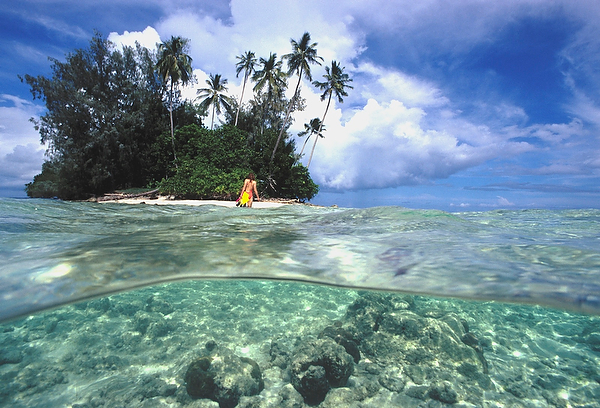
You can be forgiven if you think that choosing a pair of fins for scuba diving should be an easy task. I used to think so. After nearly 40 years of diving, I am still learning about what kinds of fins work best for me in different situations. I’ve dove in markedly different environments over the years, ranging from diving under the ice in Antarctica, to the cold temperate waters of northern California, to tropical diving around the world. I’ve gone from carrying little gear; to SLR housings as a professional underwater photographer; to large 70-pound HDCAM and film housings while wearing a drysuit and using a rebreather. My diving has ranged from carrying this gear in still, clear tropical waters; diving with double tanks in 150 foot depths with heavy currents while carrying a 70-pound camera housing; to trying to keep up with sperm whales at the surface. I’ve learned some things along the way that no book or magazine will tell you.

Every person is different, and fins for diving are perhaps the most personal and difficult choice of gear to get. I can only describe my situation and hope that this review helps other folks figure out what to look for in a diving fin. I got certified at the age of 15, I am in my mid-50s, and I’ve spent the past 25+ years working as a professional underwater photographer. I am short and round, I am in decent shape for swimming and diving, but I am 30 to 40 pounds over my ideal weight. I swim regularly at a local pool (about 1.1 miles every other day) but that has not been enough to combat my bad food habits. I have small feet and short legs compared to giant white males but my feet are wide. I am 5 feet six inches tall, my feet are size 7-1/2 and I prefer New Balance shoes since I can get them in a wide EE size.

It’s ridiculously difficult to find important information on fins. One of the criteria for choosing fins is how heavy they are. If two fins are equal in other ways, I would prefer fins that are lighter, purely because I need to minimize the weight of my luggage to avoid excess baggage fees. I was surprised that many manufacturer’s websites do NOT list the weight of their fins with their products. For instance, Scubapro has a lineup of very popular fins, but their website does NOT list the weight of their fins (or other specifications such as length of the blade). In order to find the weight of these fins, I had weigh them myself. I couldn’t find any website that listed the weight of these fins. For some manufacturer’s fins, I could go to the Leisurepro website and dig down to find this information. I did weigh every fin that I personally tested.
I undertook this review because I wanted to know what the dang fin weighs, see how it fits on a real person, get a sense of how fast or slow it is, and get a sense of how manoeuvrable the fins are. In the past two years, I spent hundreds of dollars buying fins (on sale) from LeisurePro and searching local dive stores’ clearance bins (the stores ranged from my home base in Monterey to as far afield as Bali, Maui, and West Palm Beach). I have tried out and weighed about a dozen pairs of fins, and I’ve preliminarily settled on about three favorite styles which I will use for various types of trips: classic warm-water coral reef trips where one does a lot of macro photos and needs to manoeuvre as well as swim in currents; whale and dolphin trips where one needs speed above all else; and cold-water trips (classic diving on reefs only; forget cold-water speed swimming in a drysuit!).
In the past months, as my plan for this review became clearer, I wrote to several diving manufacturers to ask them to supply their best fins for this review. The good folks at Mares, ScubaPro, and Sherwood recognized the value of such an article (as well as my 25-year history in this industry) and supplied me with a few of their models of fins to test. They were quite generous in supplying the gear, and I give them my thanks. Manufacturers who support reviews like this obviously want to get the information out there and realize that they have great products. I wanted to test some of Oceanic and Aqua Lung’s fins, but they ignored my requests. This article is a work in progress; I’d welcome trying out just about any fin and if you are a manufacturer who would like their fins included, please contact me.
I’ve had a few learning experiences over the years, and I would like to share those first.
When I started working as an underwater photographer, I traveled all over the world to tropical locations. I preferred full foot fins for the beginning of my career. As an underwater photographer, I needed fins that were easy to carry around, were powerful enough to let me photograph while swimming against currents, were light for travel, and let me manoeuvre easily to get into position underwater. I used Cressi’s full foot Free Frog fins during this period. They were relatively light (1 lb 12 oz per fin), fit my feet well, gave me enough power to swim against currents (I was carrying still cameras and strobes, not bulky film housings), and allowed me to manoeuvre underwater just fine. They held up through years of tropical diving and were a great combination of letting me manoeuvre around a reef, ease of using them, and powering in strong currents.

Starting in 2001, I started shooting video underwater with a large, bulky 70-pound housing that had an early Sony HDCAM professional HD camera in it. I then started diving with an Inspiration rebreather. I got certified with this rebreather in Mexico, then did some diving at Cocos Island with my very large HDCAM housing. Until then, I had always done my tropical diving with my trusty Cressi Free Frog full-foot fins.
I discovered, when diving with this rebreather and still camera housings off Cocos Island with my friends Howard Hall and Bob Cranston, that my Cressi full foot Free Frog fins were not capable of giving me enough power to get me through the water with a bulky rebreather on my back. These fins were just barely adequate.
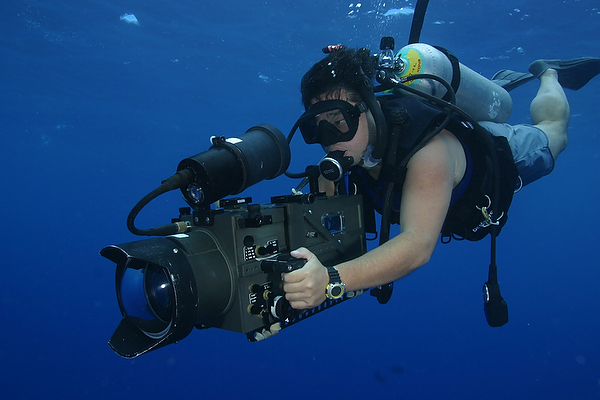
I later had to keep up with diving officer Doug Kesling and his crew at the University of North Carolina, diving with double tanks at 150 foot depths for long periods, battling strong currents and carrying a large HDCAM housing, using these same Cressi Free Frog fins. It was nearly impossible – the fins just weren’t powerful enough. I also caught a ton of flak from the crew of the NOAA research vessel for not having foot protection when walking on deck – they required adequate foot protection when walking on the deck of the boat. Rubber sole booties were barely acceptable, and fin socks were not acceptable. I had to wear booties to cross the deck, jump in the water, take my booties off, and store them in my BC pockets – a huge pain in the butt. I should have just brought some open-heel fins. With the bulk of a rebreather or double tanks, and large video housings, I quickly learned that full foot fins were not powerful enough. I needed to graduate to powerful, open heel fins. For these reasons, since I’ve started carrying heavier and bulkier gear and diving in different situations, I’ve found that open-heel fins are preferable to full-foot fins in most diving situations, even tropical diving. I have always felt, and still do, that full foot fins (which are shaped to fit a bare foot) offer more speed than open-heel fins (which have larger pockets to fit diving booties with rubber soles). However, when I am walking across the deck of a boat, walking back up a coral rubble beach of Bali, or just getting ready to dive off a small dive tender – open-heel fins make a lot more sense to me now than before. Being able to wear thick neoprene socks or booties to protect my feet in all these situations is a huge plus over having bare feet.
I am not a fan of booties, however. In my late thirties, I had a job filming mangroves in Bonaire using a large film camera. I wore some booties that zipped up the ankle. They were not particularly tight, but they nevertheless caused incredible pain when I was filming mangroves in Bonaire. This had not happened to me before. Just a few months before that, however, I had tried downhill skiing, and wearing the boots for those skis caused me similar incredible, debilitating pain. I believe that my feet widened as I aged and gained weight. Because of the problems with my booties (I had brought only open-heel fins, realizing that I would be tramping through mangroves), I bought some inexpensive snorkelling fins in town. I realized quickly that these fins really, really sucked. I won’t name the brand or model, but these are inexpensive fins marketed toward beginning snorkelers. The moral of the story is that serious divers, who are carrying a great deal of bulky gear on them that creates water resistance, need to find fins that are professional grade. Don’t get fins meant for novice snorkelers at the ABC shop in Maui and expect those fins to work well. These flimsy fins are downright dangerous, since you won’t be able to swim against the slightest current to get back to your boat.
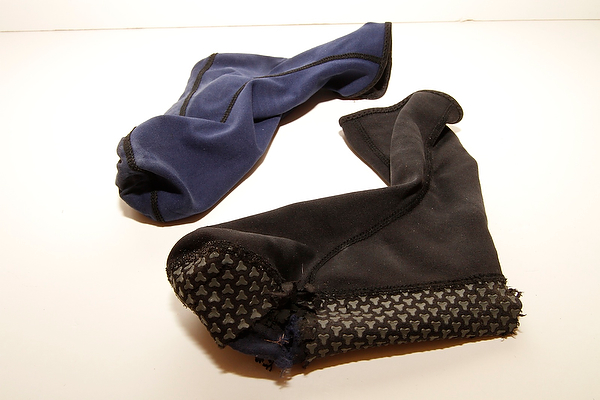
Because my feet are so sensitive to booties that are tight, I use booties that are ankle-high rather than the ones that zip up past the ankle (I prefer neoprene slippers, not booties that are tight and inflexible). I test them before bringing them on any trip, to make sure that they do not constrict my feet. I like the Tilos booties that I have now, but I still get foot cramps and pain when swimming with them. If I can get by without using booties, I much prefer wearing thin neoprene socks, that protect my feet from blisters but don’t put any pressure whatsoever on my feet. I’ve been using Henderson’s great Microprene Fin Socks for years and years.
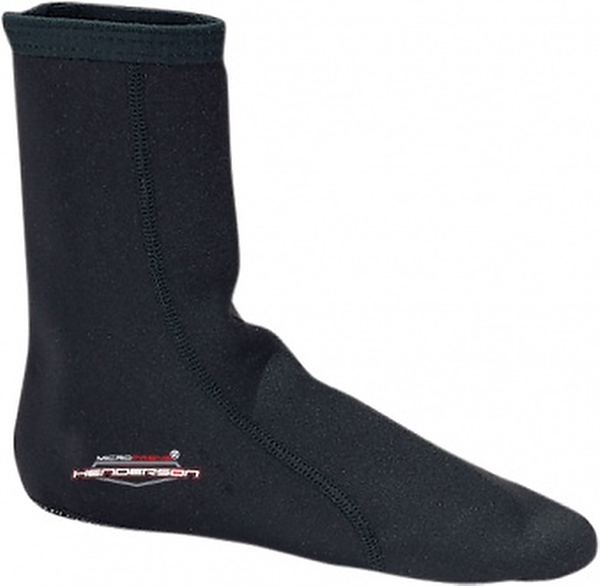
My good friend Douglas Seifert invited me on a trip to swim with sperm whales in Dominica in 2010. I learned, during this trip that involved trying to keep up with pods of whales (and the speedy Douglas!), that open heel fins, with lycra socks under a pair of booties, was the best combination for me in this situation of intense, all-day, frantic swimming. Full foot fins had always worked for me in the past in this situation – even with weeks of swimming with dolphins in the Bahamas Banks in the early days. However, as I aged, I had to take care of my feet more. Now, trying to swim too much with full foot fins, even with a lycra sock, causes a blister almost immediately. Almost nothing is worse than a blister on your foot during a diving trip. It will cause you to sit out the rest of the trip, and so I take great care now to wear Henderson Microprene fin socks (or lycra socks) under booties, along with open-heel fins (not full foot). I discovered the best pair of open-heel fins for this kind of fast snorkelling by doing this review – the surprising light, speedy Sherwood Elite open-heel fins. I discuss these fins in more detail below.
I also dive a great deal in cold water. I live on Monterey Bay in California, and the water temperature here ranges from 45 to 55° F. It’s cold, and I always wear a drysuit when diving here. Diving in northern California waters was great practice for my diving in Antarctica in 1997 through 2001, and later in 2008 and 2009. I used Cressi full-foot Frog fins for all of my diving in Antarctica in 1997 through 2001. They worked fine but are outdated. In recent years I have used Scubapro Twin Jet split fins (open heel) with my drysuit. I’ve been happy with the Twin Jet fins. They are floppy, not stiff, but the foot pocket is super-comfortable over my drysuit booties. I have been interested in how these Twin Jet fins compare to other open-heel fins.
Split Fins verus Conventional Fins:
I also wanted to see how split fins compare to conventional fins. We photographers need power sometimes, but we also need our fins to be flexible so that we can position ourselves easily and without throwing up a lot of sand. I have noticed that many divers with split fins swim too close to the bottom for some reason, kicking up clouds of sand behind them. I have heard that with split fins, divers should use a smaller, more frequent flutter kick for maximum performance.
I mentioned buying fins from dive stores’ bargain bins – I likely won’t be doing this in the future. I bought a pair of split fins and a pair of conventional fins in the past two years, and they were so bad that I can’t use them. One was a split fin, open heel design that has good reviews online. The split fins were stiff. I found that they work fine when swimming laps and sightseeing, but they were so stiff that I could not manoeuvre with them. With any kind of fin, as a photographer, I need fins that allow me to swim against currents, but just as importantly, I need fins that will accommodate a slow style of drifting and manoeuvring. Photographers will swim a bit, notice a subject, then have to turn around or back up using a backwards stroke of the fin. The Scubapro Twin Jet fins allow me to do this; the bargain bin split fins did not.
My friend Alan Studley mentions:
“You didn’t mention the cave kick, which is a modified frog kick…I mention the cave kick because it is very efficient for long swims. I can go for hours without low back pain.
In my recent course, I mentioned the efficiency of the cave kick to a student who was large and the same height as me. He was always lagging behind with his traditional Flutter kick. So the second day he tried the cave kick and was keeping up with me and with much less effort. Cave kickers usually use a stiff blade fin vs splits. I’ve used the Atomic Split and they work fine when cave kicking”.
Some fins are just too stiff and do not work for me in any way. I bought a pair of fluorescent green conventional (not split fin) open-heel fins from a local dive store. These were from a very well-known manufacturer of diving fins. Here’s what I wrote in my notes: “Tried them in the pool twice over six months to be sure. Seems to give a lot of power and manoeuvrability but is also a bit stiff, very hard on the knees, when diving with a drysuit. Could not swim with these in the pool, just too heavy and stiff. Worst fins ever, don’t name them. Tried swimming underwater with them, a little better but still slow. Very stiff, hurt my knees, did not swim well with them. Size small fit my feet with booties perfectly“
About sizing of fins: Most manufacturer’s websites and the Leisurepro website list US shoe sizes matched up with sizes small, medium, large, and extra large. These tables don’t specify if the sizes work if wearing a bootie or drysuit bootie. I have a size small foot (US men’s 7.5). I found that with a dive bootie, most fins (Mares, Sherwood Elite, Scubapro Twin Jets) match my shoe size. In other words, my shoe size of 7.5 with a bootie corresponds to a size small open-heel fin for most fins. My drysuit booties are much larger than my wetsuit booties, and fins that are another size or even two sizes up work with my drysuit (e.g. size Medium or Large in the Scubapro Twin Jets work with my drysuit booties).
How the fins fit is obviously extremely important. My size 7.5 foot in a bootie or thick neoprene sock would fit in most fins that are called size Small by the manufacturer. Some fins are sized larger, so that a size small for them might be a size Medium for others. For instance, I found the Sherwood Elite fins size Small to fit my feet with booties just fine. The Apollo fins in size Medium were way too big for my feet with booties, and in my opinion should be called size Large. I have noted if fins are a “standard” fit or oversized.
Spring Straps versus Rubber Straps:
Some fins have posts on them which allow you to put on stainless steel spring straps instead of rubber straps. I like these steel spring straps, and I commend those manufacturers who make them and who make their fins with the post, thereby making it easy for divers to put in after-market spring straps. For instance, the Sherwood Elite fins come with their own rubber straps and with the proper type of post to mount other straps on them. I was able to put on EZ Spring straps (from leisurepro.com) which I preferred over their stock rubber straps. Scubapro’s fins do NOT have these posts, but their stainless steel spring straps (from their Twin Jet Max fins) could fit into the Sherwood Elite fins since they had the same size buckle (which goes over the post). The Atomic’s buckle arrangement does sort of fit onto the “standard” post of the Sherwoods but not well or elegantly. Atomic fins have a one-off arrangement where the entire buckle comes off, not a quick release.
Testing fins:
These tests are largely subjective, but I did try to test the fins consistently. I discovered a pool close to the Monterey area where I was able to swim laps consistently in the past year. After a couple months of swimming a standard routine (three sets of 400 yards using exercise fins, and two sets of 400 yards swimming underwater and using the crawl stroke), I felt that I was in decent shape and would not get much faster. For my normal swimming with fins, I used a pair of “Pod” fins, which are simple fins used for exercise and boogie-boarding (also called bodyboarding). These are short-bladed fins made of stiff rubber.
I tested each pair of fins two or three times. I swam a quarter mile with the Pod fins first to warm up, then swam a quarter mile with the test fins, timing myself. I strived to be as consistent as possible when swimming; but in the end, the times with the fins are subjective. I rate the fins as 0, +1, +2, or -1; with “0” based on swimming times with the Pod fins. Please keep in mind that body shape and height is likely a large factor in how fins work for each person. I am a short, round guy who is not particularly athletic but nevertheless has fairly strong legs. If you are a tall, slim, collegiate swimmer, then the fins that work best for me may not work well for you. Taller folks might prefer fins that are longer than the ones that worked well for me.
I did find that some fins just didn’t work well for me at all. I have purposely declined to name these fins and their makers by name. I have found that folks in the diving industry don’t take criticism well. This attitude is regrettable – enlightened makers of dive gear should welcome honest and constructive criticism of their gear. Fortunately, most divers and photographers like my reviews a great deal because they are honest and informative.
Here’s a listing of the fins that I have tested to date, including the weight per single fin, price (at leisurepro.com unless otherwise stated); speed rating (based on time to swim a quarter mile); buoyancy; how the fins fit; and miscellaneous observations.
Pod bodyboarding fins:
1 lb 5 oz; $40 at an Oahu North Shore surf shop; +0 (baseline) speed rating; positive buoyancy; standard fit; these are considered “beginners bodyboarding fins and are good for exercise swimming because they are not too stiff.”
These fins float, which is a good thing for surfing but a bad thing for diving. I always prefer fins to sink rather than float, so that I can place them on the seafloor if needed and count on them to stay there.
“Smaller training fins provide resistance without overloading joints, ligaments and tendons. They also help shift effort to the foot, increasing leg strength by encouraging propulsion with a leg kick in the form of a pedaling motion that’s the same as a flutter kick without a fin.” (From Churchill Fins
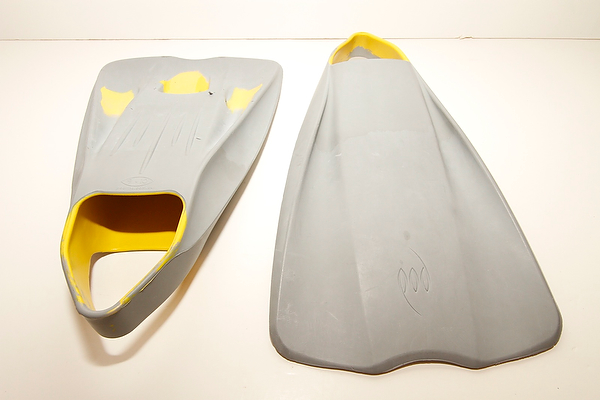
Page 1: Introduction. Page 2: Open heel fins. Page 3: Closed heel fins.